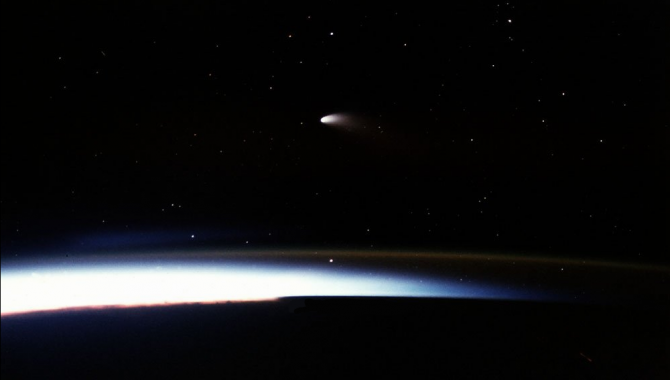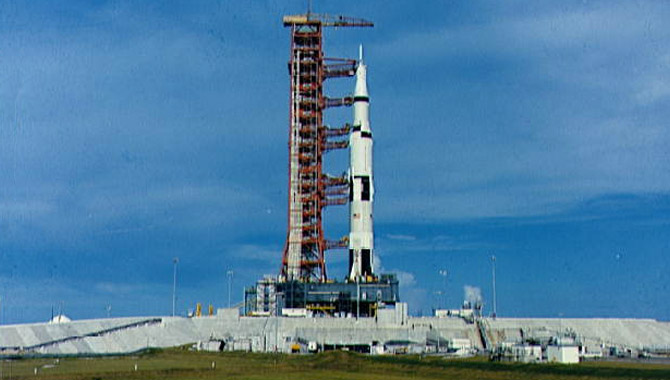
Comet Hale Bopp seen from Space Shuttle Columbia on STS-83. Credit: NASA
May 30, 2012 — Vol. 5, Issue 5
Fifteen years ago this month, a solar event triggered a rare sight.
Discovered by Alan Hale and Tom Bopp in June 1995, the 4.5-billion-year-old comet Hale-Bopp kept the scientific community busy when it neared Earth two years later. In April 1997, scientists discovered Hale-Bopp had a third tail (comets usually have two—an ion tail and a dust tail) made up of neutral sodium. Weeks later, the International Solar Terrestrial Physics (ISTP) program, an international collaboration among the European Space Agency, Japan’s Institute of Space and Astronautical Science, and NASA, alerted astronomers around the world about another rare sight. As Hale-Bopp’s orbit brought it closer to the sun, ISTP scientists predicted that a complicated interaction would take place between the comet and the magnetic field from the sun’s solar wind. In theory, the magnetic field would surround part of the comet and its charged ion tail. Any change in the magnetic field could cause a break in the tail.
Between May 1-7, Hale-Bopp was expected to pass through the sun’s equatorial plane, which is the location of the sun’s “current sheet”—the point at which the sun’s magnetic field lines change direction. When the comet crossed the current sheet, the magnetic field surrounding the comet was disrupted. As a result, the comet’s ion tail temporarily disconnected.
“It’s like a lizard losing its tail,” said William Farrell, former co-investigator on the Wind mission at Goddard Space Flight Center, “but the tail grows back and the comet lives on. It allows us a unique view into the solar wind interaction with a magnetized body.” This rare phenomenon is known as a disconnection event. Studying these events inform scientists’ knowledge about the impact of solar weather on Earth.
“The earth has a dipolar magnetic field,” explained Farrell, “and the solar wind compresses it on the front and elongates it on the back. During a solar storm the geomagnetic tail can actually stretch and compress to where magnetic field lines of opposite polarity and in opposite hemispheres merge, also creating an analogous disconnection event. At the Earth, the process is called ‘reconnection’ and a future mission called Magnetospheric Multiscale (MMS)
is designed for flying a fleet of spacecraft near and through these active regions.” Reconnection events have electrical currents that flow along magnetic field lines all the way to the upper atmosphere to create auroral displays (i.e., Northern Lights or aurora borealis) in the night sky.
While the Hale-Bopp disconnection event did happen, it was difficult to see. The brightness of the comet’s prominent dust tail obscured the view of the ion tail disruption. However, a team of scientists led by J.C. Brandt at the University of New Mexico succeeded in imaging it on May 7 and 8, 1997. Using a special carbon monoxide ion filter to see through the dust tail, the team observed “a very large disconnection event.”
Ten years later, NASA’s Solar TErrestrial RElations Observatory (STEREO) satellite captured images of a disconnection event for the comet Encke as it interacted with a coronal mass ejection in 2007. The event was observed by scientists at the Naval Research Laboratory (NRL) using the Heliospheric Imager instrument, which was part of a telescope suite the NRL flew on the STEREO spacecraft.
This effect is more than just a scientific amusement. “Comets provide an observable analog for what’s going on at Earth. It’s an amazing phenomenon to watch,” said Farrell. “There’s a lot in the literature on comet-solar wind interaction, but to be able to visualize it is really the stunning thing about this. It allows you to see what’s normally invisible.”
Comet Hale Bopp seen from Space Shuttle Columbia on STS-83.
Featured Photo Credit: NASA









